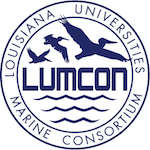I wrote ten blog posts documenting my journey at OCEANDOTCOMM. You can find those posts through the tag #odotcomm18.
 Breakfast starts at 7AM, with a hot meal prepared by the two chefs on site. There’s no Starbucks on site or even one in driving distance from the marine science station (and students, remember – there’s no Wawa in Louisiana, either!). But there was coffee and many happy people that had a good meal to start off our day.
Breakfast starts at 7AM, with a hot meal prepared by the two chefs on site. There’s no Starbucks on site or even one in driving distance from the marine science station (and students, remember – there’s no Wawa in Louisiana, either!). But there was coffee and many happy people that had a good meal to start off our day.
This morning we heard from professionals in this region that have lived and researched the Mississippi Delta. We started by hearing from Dr. Denise Reed, Professor Gratis from the University of New Orleans. She shared her perspective about the delta as a “place” – a very large, very diverse place with fresh and saline marshes, swamps barrier islands, and more. Geologically, this area of the delta is only approximately 3,000 years old. Yet, this geologically-young system is in trouble. Seeing the Land Area Change in Coastal Louisiana from 1932 to 2010 (materials available online from USGS) was very striking for us in the room. And this place is important to her and the other residents, despite the Bruce Babbitt Op-Ed piece in The New York Times, which wrote off southern Louisiana after Hurricane Katrina with, “New Orleans will survive only as an island surrounded by miles of open water.”
Dr. Reed shared her point of view as to why people live here – it is relatively flat, fertile land with a freshwater supply and natural resources, access to trade routes by land and water, and a desirable location with recreational opportunities. Reasons of natural interest might include energy, trade, and culture, but the locals find it a location for family, history, and recreation. Some families have been here their entire lives, and for generations. Yet the local people are now losing their land and feel powerless to do something about it (this piece of the story gets lost when people talk about the coast).
Here is some of what Dr. Reed shared with the group:
She concluded by telling us that we actually can do alot. The key is where we can do things, and that the projects shouldn’t be little projects (this is not sustainable for a coastal system). Her final note (not very optimistic but very real) – “There are alot of good reasons to live here, but not alot of good reasons to move here.”
 Next up was Dr. Melissa Baustian from The Water Institute of the Gulf. She shared some scientific background on the habitats in the region (swamps, marshes, mangroves, open water, barrier islands, and coastal ocean). I teach about these habitats, so I was familiar with her information. She passed around some excellent visual aids, including this great Bald Cypress knee – which no one really seems to know the purpose for! (either stability or aeration – or both!). What I was most interested in is the data they have online from their collection of data monitoring stations – I need to spend some time on the website for the Coastwide Referencing Monitoring System.
Next up was Dr. Melissa Baustian from The Water Institute of the Gulf. She shared some scientific background on the habitats in the region (swamps, marshes, mangroves, open water, barrier islands, and coastal ocean). I teach about these habitats, so I was familiar with her information. She passed around some excellent visual aids, including this great Bald Cypress knee – which no one really seems to know the purpose for! (either stability or aeration – or both!). What I was most interested in is the data they have online from their collection of data monitoring stations – I need to spend some time on the website for the Coastwide Referencing Monitoring System.
Our final speaker of the morning was Delaina LeBlanc from BTNEP, the Barataria-Terrebonne National Estuary. Her presentation on birds and their role in this system was really interesting. One of my favorite quotes from her is that, “the restoration projects – if you build them, the birds will come.” She also emphasized that many people may not know the scientific names of the birds, but they each have their own name and own stories/experiences with birds. She is hoping her and others can continue to learn more about how birds are using habitats as the habitats are changing over time. Here is a clip from her presentation:
I’m still not sure what I’ll be focusing on for my project, but I’m sure this afternoon’s fieldtrip will be helpful for deciding! I’m off to the salt marsh!
 This blog post was created from OCEANDOTCOMM and supported by the Louisiana Universities Marine Consortium (LUMCON).
This blog post was created from OCEANDOTCOMM and supported by the Louisiana Universities Marine Consortium (LUMCON).
